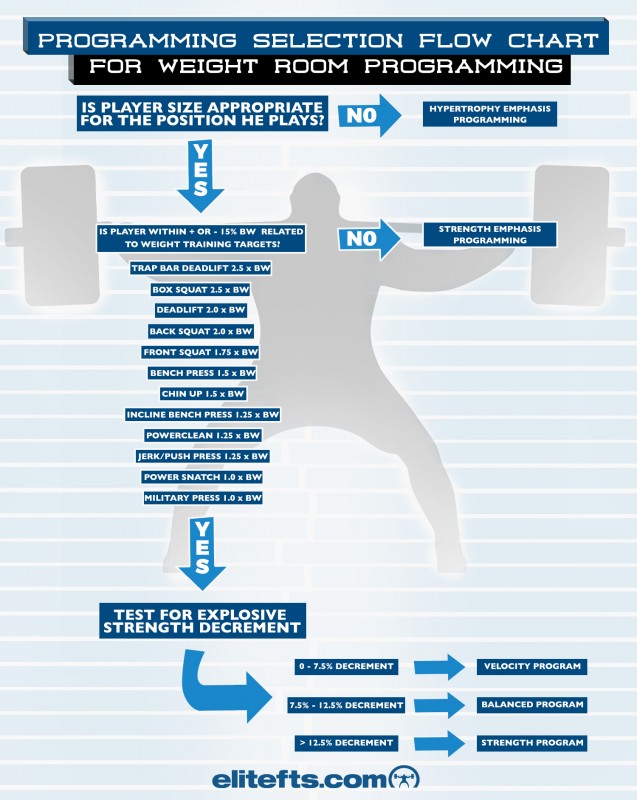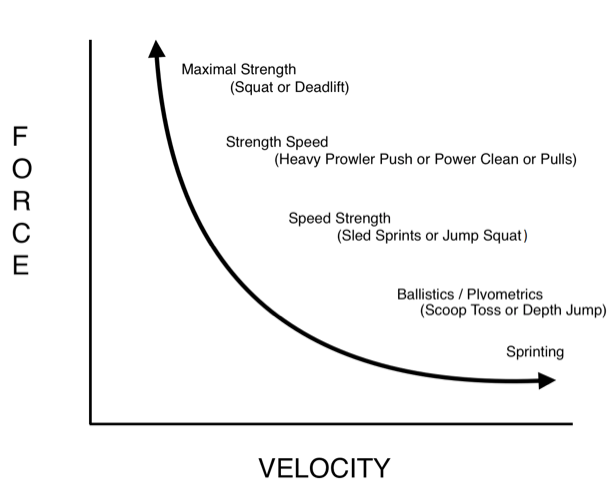
The purpose of this article is to demonstrate how you can analyze the performance of your athlete's to appropriately place them in training groups. By assessing the strengths of each athlete, you can better determine their training needs and how to address them. Let's begin by looking at the flow chart, with detailed notes to follow.
- Velocity Programming – 80% of program in the bottom 2/3 of the force-velocity (FV) curve, 20% in the top 1/3 of the FV curve.
- Balanced Programming – Equal percentage of time in each 1/3 of the FV curve.
- Strength Programming – 80% of program in the top 2/3 of the FV curve, 20% in the bottom 1/3 of the FV curve
Testing for Explosive Strength Decrement
By comparing the height jumped from a vertical jump from a static hold position with the height achieved in a counter movement jump, coaches can determine if a player requires more time in a strength based program or more time in an explosive/velocity based program. As an example, if a player has a vertical jump of 35 centimeters and a counter-movement jump of 50 centimeters, I would consider him to be in need of more strength training.
RECENT: Armour Plating the Upper Body and Power Training the Lower Body
The key is to regularly test and to slightly tweak the program on a regular basis. By using the force velocity curve as a guide to the development of specific programs, a trainer can allocate areas of the curve to improve aspects of performance specific to the player. This also would tie in very well with Velocity-Based Training popularized by Dr. Bryan Mann, by using a tendo unit or gym aware to monitor bar speeds to ensure the loading is specific to certain velocities required to stimulate gains in a certain aspect of the curve.
Strength Program Snapshot
Preparation
- Hip Mobility
- Hurdles — 10 reps forward and backward, 10 reps under. and overs
- Lunge Combination – Backward, forward, and lateral, 2 x 10 each side
Weights
- Primary Peak Force Movement (Squat) — 3 x (2/1), 90+% contrast super set with 3 x knees-to-feet jumps each set
- Primary Peak Power Movement: 6 x 3 reps @ 70-80% contrast super set with 3 x repeat long jumps each set
- Secondary Peak Force movement (Hinge): 3 x (2/1), 90+% contrast super set with 3 x knees-to-feet jumps each set
- Hamstring specific movement: 3 x 6 reps
Weighted Core Circuit (3 Times Through)
- ½ Turkish Get Up with KB x 5 each side
- Band Barbell Rollouts x 10
- Farmers Walk Implement Suitcase Deadlift x 5 each side
- Windmill x 5 each side
Power Program Snapshot
Preparation
- Neural Activation Protocol (hops, jumps, bounds)
Weights
Done as a tri-set for 5 total sets:
- Primary Power Exercise of Choice (speed-strength orientation) x 3, 60%
- Depth Jump x 3
- 10-meter sprint through timing lights
Done as tri-set for 4 total sets:
- Secondary Power Exercise of Choice (strength speed orientation) x 4, 80%
- Hurdle Jumps x 3 into a 20-meter prowler push
- Primary Peak Force Movement (usually squat or deadlift) 3 x 2, 90%













Wow, just wow. You never cease to amaze me with your ease and ability to express a complex topic so easily. It's so easy to get caught up in programming, yet you make it beautifully simple. I really enjoyed this read and thank you!
-Do you athletes have to meet ALL of the Bodyweight-relative training targets before transitioning to the test for Explosive Strength decrement?
-Can you please further explain the part about +/- 15% BW.
example:
I weigh 214 lbs. and my trap bar dead is 405 lbs. (broke my hand, grip sucks, don't make fun)...
based on the standard of 2.5x BW, i would need to trap dar dead 535 lbs. (214 x 2.5=535)
now, 15% of 535 lbs. is 455 lbs., and while i'm not there yet is THAT my goal/marker?
OR
is it that i can trap dead 405 lbs. and the BW associated with that weight is 162 lbs (405/2.5=162), and the high range of +/-15% of 162 is 186lbs. and i don't fall in that category either. BUT my current BW of 214lbs. is within 15% of 186lbs., therefore should be goal/marker trap dead lift be 465lbs. (186 x 2.5=465) ?
i know in my example 10lbs. seems negligible, however if I was heavier or stronger the difference between the two methods would increase.
thank you for all you do!
Primary Power Exercise of choice (speed strength orientation) 5 x 3 @ 60%
s/s Depth Jump 3 reps
Secondary Power Exercise of choice (strength speed orientation) 4 x 4 @80%
s/s 3 Hurdle Jumps
Workout 1
Cambered bar Incline Bench Press s/s Band assisted Wide Grip Chins 5 x 6 - 10
Trap Bar Shoulder Press s/s Thick Bar Upright Row 5 x 6 - 10
Bench Bar position 2 Close grip Bench Press s/s Prone Row 5 x 6 – 10
E Z Bar Curls s/s EZ Bar Lying Triceps Extensions 3 x 6 – 10
Workout 2
Triple Angle Drop Incline DB Bench Press (45,30,15 degrees)
3 x 5/5/5 or 4 x 4/4/4 or 5 x 3/3/3
MMA KB Floor Press s/s KB Renegade Row 4 x 6 each side
KB See Saw Shoulder Press s/s KB Alternate Upright Row 4 x 6 each side
3 way Shoulder Raise (DB lateral, Plate Front, Bentover Cable Lateral) 3 x 12
Workout 3
DB Flat Bench s/s DB One Arm Row 5 x 6 – 10
DB Incline Bench Press s/s DB Upright Row 5 x 6 – 10
DB Seated Shoulder Press s/s Seated DB Snatch 4 x 6 each side
DB Twist Curls s/s Seated DB Overhead Extensions 3 x 6 – 10
Workout 4
Hammer Incline Chest Press s/s Hammer Low Row 5 x 10
Hammer Shoulder Press s/s Hammer High Row 5 x 10
Triceps Death s/s Matrix Bar Curl (special sets/reps) 4 sets
Cheers
Week 1 (May 6): 3 x 3 minutes @ 20/20 rest 1.5 minutes between sets
Week 2 (May 13: 3 x 4 minutes @ 15/15 rest 2 minutes between sets
Week 3 (May 20): 4 x 5 minutes @ 10/10 rest 2.5 minutes between sets
Week 4 (May 27): 2 x 5minutes/4 minutes/3 minutes @ above intensities & rest periods
I was wondering how you work out the distances based off the 2.4km time trial
Many thanks
I some what wish I had found this information younger 14 years ago when I was playing competitive rugby and training in the gym with no clue!
I hope some youngsters can get to read and make use of this great information and get themselves into a position where they can be physically ahead of their competition..
there are any ranges for CMJ and SJ to identyfy the athlete needs? ( velocity,strength or balance programminfg)
Reards
I love this flow chart! So simple but yet so effective!!! I found it from reading some of Cameron Josse's work. I did read Dave's comment and your reply but I wanted to clarify. When figuring out the maxes I didn't know which of 2 ways to calculate it.
For example for someone who weighs 250lbs when figuring out the Trap Bar Deadlift range of maxes.
Option 1:
250*2.5=625
-15%= 250*(2.5-0.15)= 587.5
Option 2:
250*2.5=625
-15%= 625-(625*0.15)=531.25
Thank you so much for your help.
250 x 2.5 = 625
625 x 0.15 = 93.75
625 - 93.75 = 531.25
All the best with your training training processes to achieve your goals, cheers ashley
Options that i use :
extensive intervals
Hiit training for increase the EPOC
and working at the same time with the caloric deficit .
You use any thing in specific?
Monday
Beastly Circuit 6 sets of 6 reps on each
Deadlift/Hang Clean/Push Press/Front Squat/Bent-over Row/RDL
750m Concept II row in between each circuit
Back Squat s/s Bench Press
Wk1: 4 x 6, Wk2: 6 x 4, Wk3: 5 x 5, Wk4: 8 x 3
Wednesday
Beastly Circuit 6 sets of 6 reps on each
Power Snatch from floor/Overhead Squat/Push Jerk behind Head/Combo Good Morning/Jump Squat/Power Clean from Hang
2km Watt Bike in between each circuit
Deadlift s/s Push Press
Wk1: 4 x 6, Wk2: 6 x 4, Wk3: 5 x 5, Wk4: 8 x 3
Friday
Beastly Circuit 6 sets of 6 reps on each
3 position Clean/Push Press/Jump Split Squat/Hang Snatch/Split Jerk behind Neck/Good Morning
Front Squat s/s Incline Bench Press
Wk1: 4 x 6, Wk2: 6 x 4, Wk3: 5 x 5, Wk4: 8 x 3
Saturday
Cross Country fartlek Run
Wk1: 20 minutes, Wk2: 25 minutes, Wk3: 30 minutes, Wk4: 40 minutes